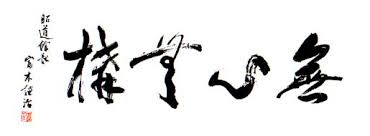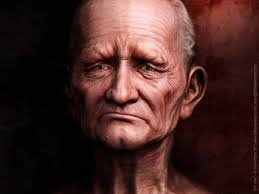In articles I have read Ueshiba Sensei was very impressed with his calligraphy. Apparently from a young age he was influenced by the fine arts of Japan. His uncle is cited as a major influence on his artistic development. His Uncle's name was Hyakusai Hirafuku. He was a famous painter and illustrator and the internet is full of his work and collections.
The Cherry Blossom blog writes of Hyakusai Hirafuku.
"He was born and brought up in 角館 (Kakunodate) , which is famous for the birthplace of 小田野直武 (おだの なおたけ)(Odano Naotake)(1750 – 1780), one of the greatest painters of Akita ranga (秋田蘭画) , also known as the Akita-ha (秋田派). 平福百穂 (Hirafuku Hyakusui) was greatly influenced by Akita ranga (秋田蘭画) and earnestly tried to introduce and spread its style, in which the Akita painters for the most part painted traditional Japanese themes and compositions using Western-style techniques and an approximation of oil paints."
Cherry Blossom
I have been searching long and hard for examples of Kenji Tomiki's calligraphy and art work, and thus far they have been very hard to find. Anyone who is known for calligraphy will have thousands of examples of their work out there, but as of yet this is all I have been able to collect.
Here is a tiny blog friendly sized version of his most famous piece. It says 'Mushin Mugamae' 無心 無 translates to 'No Mind, No Stance'.

larger version of Mushin Mugamae
In the signature of Tomiki Sensei taken from the Mushin Mugamae painting. He signs it ShodokanCho, Tomiki Kenji

Above is from a signature on the back of a photograph.
It reads Aikido 合気道 on the right
and Tomiki, Kenji 富木 謙治on the left.
Here is a unstamped piece some lucky collector in Japan stumbled upon.
I believe I am introducing the next two pieces to the internet. I posted on E-budo that I was searching for examples of Tomiki's work and these showed up in the mail.
Looks like this one says something like "gentle 柔 heart/mind 心 beauty 美 ki/spirit 気"
I blew up the signature on the bamboo painting.
The hanko taken off the bamboo painting. I blew it up and sharpened it a bit.

The three panel piece is in a single frame and hung in Mumpower Sensei's dojo. I sent the piece to some calligraphy friends in Japan. They sent beck this.
I consulted some top calligraphers in Japan.
"After consulting with the man (Ikeda Sensei), we believe the centre panel of the panel piece says:
「修自然禮之妙用」
which is new to the both of us and I can find no references to it on the internet. Ikeda-sensei believes it should be read in Japanese as:
自然礼(しぜんれい)の妙用(みょうよう)を修む(おさむ)
We're not sure if the second character is 「自」or 「百」. If the latter, then it doesn't make sense. If the former, then it is 誤字."
「禮」"thanksgiving, gratitude"
「妙用」"marvelous workings"
「修」 "make a part of oneself".
Notes from opening of the Shodokan
from https://www.tomikiaikido.ie/kenji-tomiki-speech-shodokan-dojo
Here is a sampling of some of his pieces from a book the J.A.A. in Japan recently released. There are a few new ones in there I have not seen before. When time allows I will pull them out and enlarge them.
 |
| Mushin -無心 'no mind' is written with orange bamboo. |
I wish to preserve his art and give an interested audience access to it. If you have translations, examples of Tomiki's work, or leads to people who might have examples of his work, please email me at thedragonsorb@gmail.com Even copies of his signature or known hankos will help in this long term project.




























